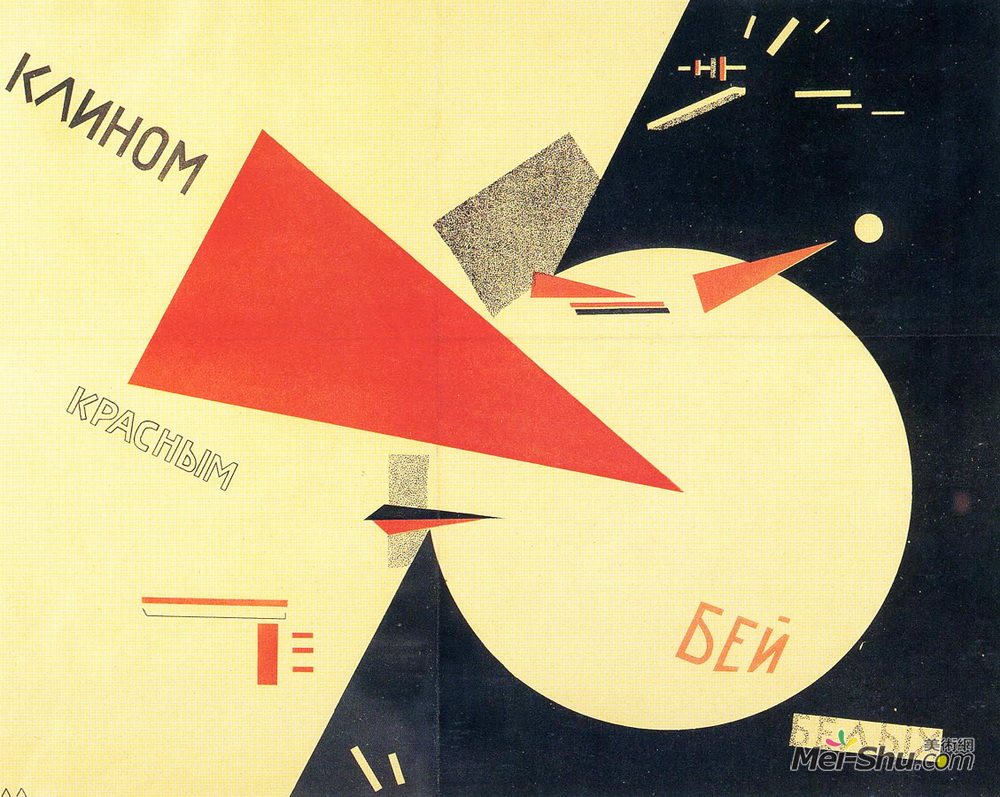 埃尔·利西茨基(El Lissitzky)高清作品《用红楔子打白》
埃尔·利西茨基(El Lissitzky)高清作品《用红楔子打白》
作品名:用红楔子打白
原名:这是一个红色的红色的白色。
艺术家:埃尔·利西茨基
年代:1920、白俄罗斯维特伯斯克
风格:至上主义
类型:海报
介质:光刻,纸
标签:海报和广告
用红色楔子敲打白色是Lissitzky最早的宣传艺术之一。1917年布尔什维克发动革命后不久,他创作了这部充满政治色彩的作品以支持红军。红色的楔子象征着革命者,他们渗透着反共的白人军队。在这里,Lissitzky使用他的签名编码的红色、白色和黑色组合,这加强了作品标题所表示的信息。颜色和形状直接具有象征意义。例如,白色圆圈平滑的曲线形墙壁被红色三角形的尖端刺穿:红军刺穿了白军的防御工事。戏剧性的色彩对比也会造成空间的混乱,哪些区域是积极的?哪一个是否定的?同时,有限颜色方案中的小几何形式像微小的弹丸一样漂浮在文本中的空间中。这里,基本形式与实际文本相结合:绘画和排版被融合。这部作品是李斯特茨基的重要先驱,当至上主义艺术移到三维视觉平面上时。
Title:Beat the Whites with the Red Wedge
Original Title:Клином красным бей белых
artist:El Lissitzky
Date:1920; Vitebsk, Belarus
Style:Suprematism
Genre:poster
Media:lithography,paper
Tag:posters-and-advertisements
Beat the Whites with the Red Wedge is one of Lissitzky's earliest attempts at propagandistic art. He produced this politically charged work in support of the Red Army shortly after the Bolsheviks had waged their revolution in 1917. The red wedge symbolized the revolutionaries, who were penetrating the anti-Communist White Army. Here Lissitzky uses his signature coded color combination of red, white and black, which reinforces the message indicated by the work's title. Colors and shapes take on directly symbolic significance. For example, the smooth, curvilinear walls of the white circle are pierced by the sharp point of the red triangle: the Red Army has pierced the defenses of the White Army. Dramatic color contrasts also create confusion regarding space-which area is positive? Which is negative? Meanwhile, small geometric forms in the limited color scheme float like tiny projectiles through the space along with text. Here, basic forms combine with actual text: painting and typography are fused. This work is an important precursor to Lissitzky's Prouns, when Suprematist art moved onto a three-dimensional visual plain.
作品名称:《用红楔子打白》埃尔·利西茨基(El Lissitzky)高清作品欣赏
作品链接:https://www.mei-shu.com/famous/26216/artistic-63370.html
作品类别:油画
免责声明:本站部分公开资料来源于互联网,目的是用于学术交流与讨论,并不代表本网赞同其观点和对其真实性负责。如果您认为我们的侵犯了您的权益,请与我们联系(banquan#mei-shu.com #替换为@),我们将在第一时间删除相关内容。